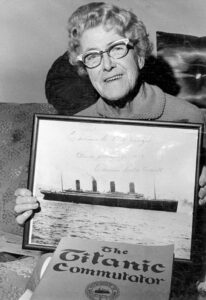by Dennis Dalman
Edwina “Winnie” Troutt was one lucky woman. She not only survived the sinking of the Titanic, she also outlived three husbands, endured a near-deadly bout of pneumonia and then went on to continue living a long productive life, despite having the use of only one lung.
She lived to be 100, dying on Dec. 3, 1984.
Troutt was a cousin of the late Bernice Traut, the mother of John Villcheck, a longtime Sartell resident. In an interview with the Newsleader, Villcheck explained “Traut” is a variable spelling of “Troutt.” The name was changed to “Traut” by many of the Troutt relations during World War II, Villcheck noted.
In 1972, Edwina “Winnie” Celia Troutt traveled from southern California to Central Minnesota to attend a multi-family reunion in St. Stephen. The reunion was hosted by members of the Traut and Supan families, many of whom are related. As far as Villcheck can remember, that was the only time Troutt visited central Minnesota.
Coal strike
On April 10, 1912, Edwina Troutt (born in 1884 in Bath, England and raised in that city), arrived in Southampton on the south coast of England for a transatlantic voyage to New York City. There, at the English port, she learned that because of a coal strike in England, the ship she had a ticket for (named the Oceanic) could not sail because it had not enough coal to power the ship for the long journey. Instead, she was allowed to board another passenger ship, one that was called the Titanic, which had plenty of pre-stored coal on board.
Troutt’s plan was to travel to the United States to be with a sister who was about to birth a baby in Auburndale, Massachusetts, where she lived with her American husband. It would not be Troutt’s first visit to America. In 1907, she came to the United States and stayed there for nearly five years, working as a preschool teacher, as a clerk in her brother-in-law’s tobacco shop. She had also worked as a waitress in New Jersey and as a domestic housekeeper in Auburndale. She returned to England in 1911.
Cabin 101
At Southampton, a long line of passengers (first class, second class, third class) waited to board the Titanic. Edwina Troutt, 27, was assigned to cabin 101, a second-class accommodation on E deck. She had two cabin-mates – an English woman, Susan Webber; and an Irish woman, Nora Keane.
The Titanic was a magnificent ocean liner, so large and ornate that it had a gymnasium, a large dining area and a ballroom with its grand staircase. The three women were enjoying their voyage, dining and chatting with other passengers.
Nora Keane, however, had some troubling fits of nervousness. She kept telling Troutt the ship would not make it to New York. A superstitious Irish woman, Keane had dropped her rosary and prayer book to the deck when boarding the ship, fearing that was an omen of impending doom.
Journey begins
Recently built in Belfast, Ireland, the Titanic was at that time the largest passenger liner in history. It was also widely touted as “unsinkable” because of its innovative water-proof, double-hull design. The journey from Southampton to New York was its first trip, its maiden voyage.
After setting out from England, five days later, on April 15, 1912, the unsinkable Titanic sank in the North Atlantic after hitting part of a huge iceberg. It took about three hours for the giant ship to submerge totally beneath the surface to the ocean’s bottom two miles below. It happened east of Newfoundland, a few hundred miles northeast of New York.
The unthinkable, unprecedented disaster sent shock waves throughout the world.
(The complete article will be printed in the Feb. 17 Newsleader.)

Late in her life, Edwina “Winnie” Celia Troutt (MacKenzie), holds a photo of the magnificent but doomed passenger liner, the Titanic. She was aboard the ship when it struck an iceberg in the North Atlantic Ocean on April 15, 1912. Troutt survived the disaster and went on to live a long, productive life, living to be 100.




